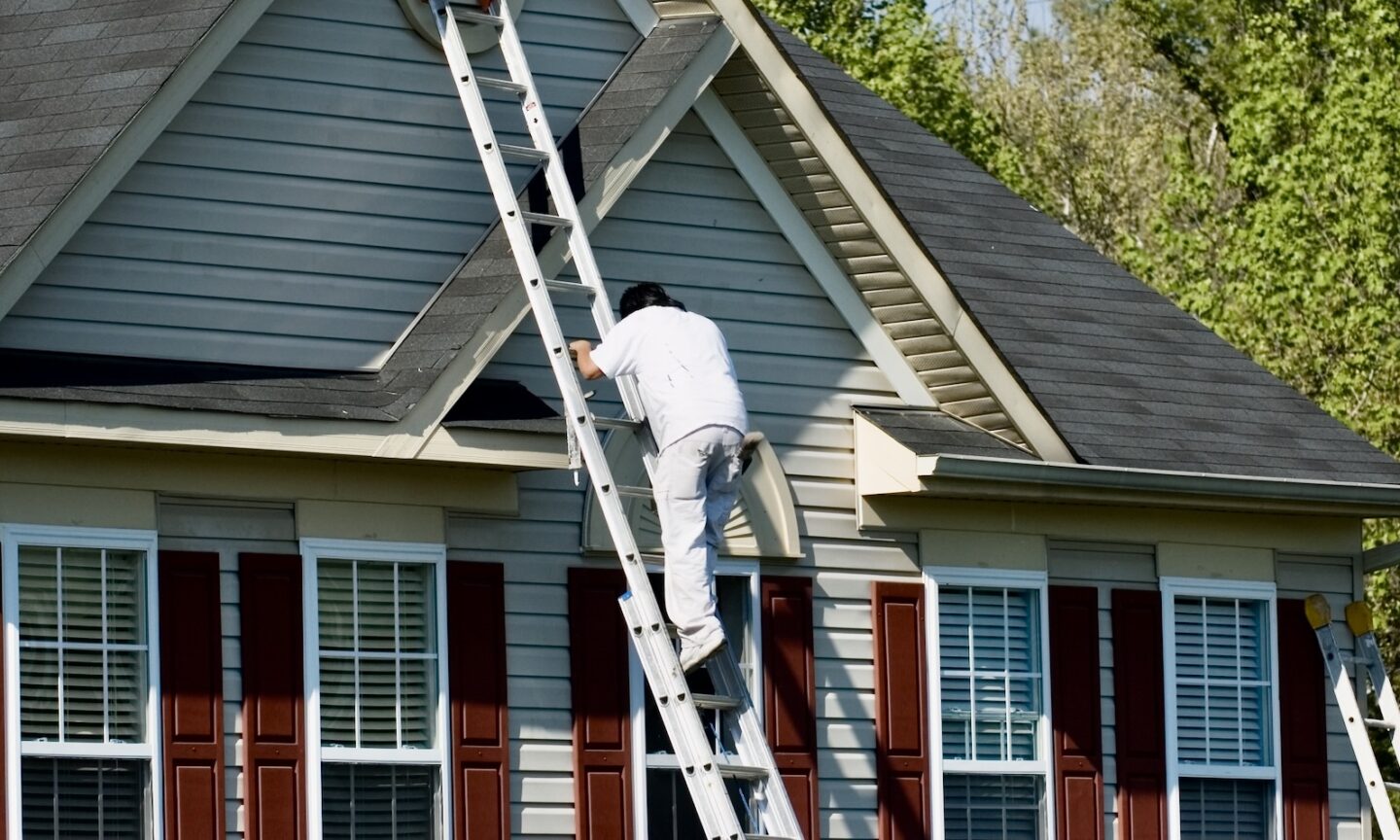Can You Paint Vinyl Siding?
You can paint vinyl siding if it's in good condition, but a successful outcome depends on proper preparation and the paint you use.

Some or all of the mortgage lenders featured on our site are advertising partners of NerdWallet, but this does not influence our evaluations, lender star ratings or the order in which lenders are listed on the page. Our opinions are our own. Here is a list of our partners.
On this page
Vinyl siding has long been a popular option for home exteriors, but what happens when its color fades or you want a different look? Can vinyl siding be painted instead of replaced? The answer is yes, but painting vinyl siding isn’t quite as simple as grabbing a brush and a bucket of paint.
Here’s everything you need to know about painting your vinyl siding — including cost, benefits and drawbacks, proper preparation and paint types, and whether to do-it-yourself or hire a pro.
What is the cost to paint vinyl siding?
Painting vinyl siding is a more affordable option than replacing it. Your final cost depends on factors like the size of your home and whether you do the painting yourself.
- Hiring a professional. If you hire a pro, expect to pay from $2,000 to $6,000 for a 2,000-square-foot home. While this is a more expensive option, it can ensure everything from prep work to painting is done properly. It may also include a warranty to guarantee work quality.
- As a DIY project. You can paint vinyl siding yourself, if you have the skills and can do the job safely — for example, being able to climb a ladder to a home’s second story. DIY painting of vinyl siding ranges from $300 to $1,000 for a 2,000-square-foot home, according to home services website Angi. Your final cost depends on the amount of paint you need and whether you have to rent or buy equipment, such as a paint sprayer and painting tools.
In comparison, replacing your vinyl siding can cost from about $6,000 to $18,000. Still, replacement may be the best choice if your siding is old or damaged, meaning a paint job isn’t likely to last long.
When is it a bad idea to paint vinyl siding?
Before you decide to paint your vinyl siding, be aware of these reasons it may not be a good idea.
- The siding is brittle, warped or cracked. Painting over damaged siding may lead to cracking paint later.
- The surface has significant mold, mildew, dirt or chalky buildup. If you can’t clean these areas, the paint may not adhere correctly and you may have an uneven finish.
- You're planning to go significantly darker than the current color. Dark paint colors tend to absorb more heat, so if you live someplace hot, dark paint can warp the siding.
Pros and cons of painting vinyl siding
Here’s a quick comparison of the benefits and disadvantages that may come with painting your vinyl siding.
| Pros | Cons | Considerations |
|---|---|---|
| Less expensive than replacement. | Could void any manufacturer warranty. | Check with the siding manufacturer about warranty requirements first. |
| Plenty of custom color options available. | Paint suitable for vinyl siding costs more than other exterior paint types. | Look for "vinyl-safe" exterior paint, preferably 100% acrylic. Costs about $20-$80 per gallon. |
| Improves visual appeal of home. | Requires specific prep and care to maintain appearance. | Will need to be repainted about every 10 years, maybe sooner without proper prep. |
| Can protect siding and extend its life. | Not an option if siding is already in poor condition. | Inspect siding for damage before painting. Weigh whether painting or replacement is best. |
How to paint vinyl siding
Painting vinyl siding is doable for many DIYers, but success depends on preparation and using the right materials. Here’s a brief, step-by-step overview.
1. Inspect the siding
Check for damage like cracks or loose panels. You will need to address any issues before painting.
2. Clean thoroughly
Use a pressure washer or scrub with a solution of water and mild detergent to remove dirt, mildew and chalky residue. Allow at least two days after cleaning to ensure the siding is dry before painting it.
3. Prime the siding
Priming for vinyl siding paint isn’t usually necessary if your siding is in good condition and you use high-quality paint made for vinyl. But priming can improve adhesion and coverage, especially if your siding is faded or a dark color. If you aren’t sure whether a primer is needed, it’s best to go ahead and use one.
4. Use the right paint
Choose an exterior 100% acrylic paint labeled as “vinyl-safe.” These paints are formulated to expand and contract with vinyl. Avoid dark colors unless they’re labeled safe for vinyl. Dark shades absorb heat, which can cause siding to warp.
5. Apply paint
Using a paint sprayer is the best approach when painting vinyl siding, because it provides more even coverage. It’s possible to use a brush or roller, but they are better for touching up smaller areas. Apply at least two coats of paint, and follow the paint manufacturer’s recommended drying times.
6. Maintain regularly
Vinyl siding should be cleaned once or twice a year to remove dirt and prevent mildew buildup. Repair any damage and touch up paint scratches right away. Repaint when you notice significant fading or wear. Depending on where you live, this could be every five to 10 years.
Paying for the cost to paint vinyl siding
Credit card
A credit card can be an easy way to pay for lower-cost projects that you intend to pay off quickly, but be aware that credit cards tend to have higher interest rates than other financing options. When used responsibly though, credit cards can come with great benefits, such as 0% introductory APR periods that allow you to avoid interest for a set number of months or rewards so you earn cash back, travel or points. If you buy your toilet from a home improvement store, you will probably be offered a store credit card (if you don’t already have one). Before you accept that offer, compare to make sure you choose one of the best credit cards for home improvements.
Personal loan
Many banks, credit unions and online lenders offer personal loans, with amounts usually from $1,000 to $50,000, although you can find lenders who will go as low as $250. You receive a lump sum and repay it in equal monthly installments over a set period, typically two to seven years. APRs are fixed and can range from 6% to 36%, with the lower rates typically going to borrowers with better credit.
Home equity loan or HELOC
A home equity loan or HELOC could make sense for a project on the higher end of the cost range, especially if you hire a contractor to paint your vinyl siding or include other home improvements.
Home equity loans and HELOCs tend to have lower interest rates than other types of financing, and possible tax benefits. Both options use your home as collateral.
- Home equity loan. This may be a good option if you won’t need ongoing access to money for additional home improvements. With a home equity loan, you receive a lump-sum payment and then pay it back at a fixed interest rate over an agreed period of time, typically five to 30 years.
- Home equity line of credit. HELOCs work more like a credit card, so you have ongoing access to money as you need it. You usually have 10 years to draw from the line of credit and pay interest only on the HELOC amount you use. Most lenders have an option for interest-only payments during that time, after which you’re required to pay both the principal and interest. HELOC interest rates typically are variable, meaning your monthly payment could rise or fall over time.
Is painting vinyl siding worth it?
Painting vinyl siding is a cost-effective solution to refresh your home’s appearance and extend the siding’s lifespan. But before you dive into painting it, consider your budget, the time it will take and your desired outcome.
Whether you DIY or hire a pro, the right preparation, tools and paint are critical for long-term performance. If you decide hiring a painter is the right choice for you, get at least three quotes to ensure competitive pricing. And, if your siding is too worn or damaged, realize that replacement might be the better investment.
Frequently Asked Questions
Can I paint vinyl siding a darker color?
Yes, but make sure the paint is labeled “vinyl-safe.” Dark colors absorb more heat and can cause the siding to warp if not properly formulated.
How long will painted vinyl siding last?
Expect about 10 years of good performance if the paint and prep were done correctly, although weather conditions where you live can affect this timeframe. Using premium vinyl-safe paint can maximize longevity.
Should I paint vinyl siding myself or hire a professional?
DIY painting gives you full control over the project and can save money if you have the time, tools and patience. However, hiring a pro ensures proper prep, a polished finish, quicker turnaround and less hassle for you. A professional painter is also likely to offer a warranty to guarantee quality work.
Does weather matter when painting vinyl siding?
Yes. Mild weather—between 60°F and 85°F—is ideal to ensure the paint adheres and lasts a long time. Avoid painting in extreme heat, cold or humidity.
Where can I buy vinyl siding paint?
Popular paint manufacturers like Sherwin-Williams, The Pittsburgh Paints Company, Behr and Benjamin Moore all make 100% acrylic exterior paints that work for vinyl siding.
Article sources
NerdWallet writers are subject matter authorities who use primary,
trustworthy sources to inform their work, including peer-reviewed
studies, government websites, academic research and interviews with
industry experts. All content is fact-checked for accuracy, timeliness
and relevance. You can learn more about NerdWallet's high
standards for journalism by reading our
editorial guidelines.
More like this
Related articles






